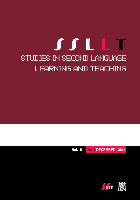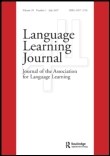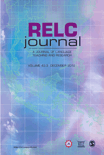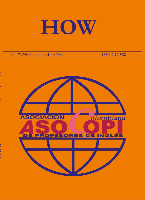
LANGUAGE LEARNING & TECHNOLOGY
Scope & Guideline
Championing Accessibility in Language Learning Innovations
Introduction
Aims and Scopes
- Technology-Enhanced Language Learning:
The journal emphasizes research on how technology, including digital tools and platforms, facilitates language learning and teaching. This includes studies on computer-assisted language learning (CALL), mobile-assisted language learning (MALL), and the integration of software and applications in language education. - Feedback Mechanisms in Language Learning:
A significant area of focus is the exploration of feedback types—such as automated feedback, peer assessment, and teacher feedback—and their effects on learners' language development and performance. - Innovative Assessment Methods:
The journal publishes research on various assessment techniques, including automated speaking assessments, dynamic assessments, and the use of technology in evaluating language proficiency. - Collaborative Learning in Digital Environments:
Research on collaborative learning through digital platforms is highlighted, exploring how technology can foster peer interaction, negotiation of meaning, and collective learning experiences. - AI and Language Learning:
The impact of artificial intelligence and machine learning on language education is a growing area of interest, investigating how AI tools, such as chatbots and automated writing evaluation systems, can assist learners and educators. - Multimodal Learning Approaches:
The journal promotes studies that incorporate multimodal resources—combining visual, auditory, and textual elements—into language learning, enhancing the learning experience through diverse forms of content.
Trending and Emerging
- Artificial Intelligence in Language Learning:
There is a significant increase in research exploring the application of AI technologies, including chatbots and personalized learning algorithms, in language education. This trend highlights the potential for AI to transform pedagogical practices and learner experiences. - Collaborative Online Learning:
The rise of remote and hybrid learning environments has led to a surge in studies focusing on collaborative online learning experiences, emphasizing peer interaction and co-construction of knowledge in digital contexts. - Augmented and Virtual Reality in Language Learning:
Emerging research on the use of augmented reality (AR) and virtual reality (VR) technologies in language learning is gaining traction, suggesting innovative ways to engage learners and create immersive learning environments. - Mobile Learning Innovations:
The growth of mobile-assisted language learning (MALL) is reflected in the increasing number of studies analyzing the effectiveness of mobile applications and tools in supporting language acquisition. - Gamification and Game-Based Learning:
There is a rising interest in gamification strategies and game-based learning approaches, as researchers explore how these elements can enhance motivation and engagement among language learners.
Declining or Waning
- Traditional Language Teaching Methods:
Research focused on conventional language teaching methodologies is decreasing. The shift towards technology-driven approaches has overshadowed discussions on traditional pedagogies, which are now less frequently addressed. - Face-to-Face Interaction in Language Learning:
As the emphasis on online and hybrid learning environments increases, studies centered on in-person language learning interactions are becoming less common, reflecting a broader trend towards digital communication. - Static Learning Materials:
The use of static, non-interactive learning materials is waning in favor of dynamic, interactive content. Research that does not incorporate technology or interactive elements is rarely featured in recent publications. - Generalized Language Proficiency Assessments:
There has been a noticeable decline in studies focused on traditional, standardized language proficiency assessments as the field shifts towards more tailored and technology-enhanced evaluation methods. - Single-Modal Learning Approaches:
Research focusing solely on single-modal approaches to language learning is decreasing, as there is a growing recognition of the benefits of multimodal and interactive strategies.
Similar Journals

Studies in Second Language Learning and Teaching
Fostering dialogue in the realm of language learning.Studies in Second Language Learning and Teaching is a premier open-access journal dedicated to advancing research and scholarship in the fields of education, linguistics, and language acquisition. Published by ADAM MICKIEWICZ UNIVERSITY, KALISZ, this journal has consistently achieved high acclaim, reflected in its impressive Q1 rankings in both Education and Linguistics and Language categories for 2023. With a robust focus on innovative methods, effective pedagogical strategies, and interdisciplinary approaches, Studies in Second Language Learning and Teaching aims to facilitate dialogue among researchers, educators, and practitioners, fostering a deeper understanding of language learning and teaching in diverse contexts. Since its transition to open access in 2011, the journal has expanded its reach, providing valuable resources and research findings to a global audience. With an exceptional Scopus ranking placing it in the top percentiles across multiple categories, this journal stands as a crucial platform for the dissemination of ground-breaking research in second language education.

Studies in Self-Access Learning Journal
Unlocking the potential of self-access learning worldwide.Studies in Self-Access Learning Journal is a pioneering academic outlet dedicated to the exploration and advancement of self-access learning practices across diverse educational contexts. Published by Kanda University of International Studies in Japan, this open access journal has been committed to disseminating high-quality research since its inception in 2010, facilitating global access to valuable insights in the fields of Computer Science Applications, Education, and Linguistics and Language. With a significant presence in academic databases, the journal has achieved notable rankings, including Q3 in both Computer Science Applications and Education, and Q2 in Linguistics and Language for 2023. Its emphasis on innovative practices in self-directed learning makes it an essential resource for researchers, educators, and practitioners alike, who are looking to contribute to and benefit from the latest findings in this dynamic area of study. As the journal continues to evolve through its converged years from 2019 to 2024, it remains a vital forum for scholarly dialogue, encouraging multidisciplinary collaborations and enriching the educational landscape.

Journal of Language Teaching and Learning
Fostering Excellence in Language PedagogyJournal of Language Teaching and Learning, with ISSN 2146-1732, is a pivotal peer-reviewed publication dedicated to advancing the fields of language education and linguistics. Published by JOURNAL LANGUAGE TEACHING & LEARNING in Ankara, Turkiye, this journal aims to disseminate cutting-edge research, innovative teaching strategies, and critical analyses that serve the diverse needs of language teachers and learners globally. As an open-access journal, it is committed to providing unrestricted access to high-quality research, making it an invaluable resource for researchers, educators, and students alike. With a strong focus on promoting effective language acquisition and pedagogical practices, the Journal of Language Teaching and Learning holds an important space in the academic landscape, encouraging scholarly dialogue and collaboration in the pursuit of linguistic excellence.

Language Learning Journal
Fostering global dialogue in language learning advancements.Welcome to the Language Learning Journal, a premier resource for researchers, educators, and linguists alike, published by Routledge Journals, Taylor & Francis Ltd. With a proud history dating back to 1990 and commitment to advancing the exploration of language acquisition, this esteemed journal boasts an impressive impact factor within Q1 rankings across both the Education and Linguistics and Language categories. Ranked #40 in Language and Linguistics and achieving a 96th percentile in the Arts and Humanities, the journal serves as a crucial platform for disseminating cutting-edge research, innovative methodologies, and impactful discussions in the field of language learning. Although currently not offered as an open access publication, the depth and quality of content ensure significant contributions to the body of knowledge for professionals and scholars. With its global reach, the Language Learning Journal is dedicated to fostering the development and understanding of language learning processes, enabling readers to stay informed about the latest trends and findings through rigorous peer-reviewed articles.

RELC Journal
Challenging Perspectives, Inspiring Change in Language EducationRELC Journal, published by SAGE Publications Ltd, stands as a leading platform in the fields of Education and Linguistics, boasting an impressive Q1 ranking in both categories according to the latest metrics. Established in 1970 and continuing its commitment to academic excellence through 2024, the journal features rigorous peer-reviewed research that explores the intersections of language, culture, and pedagogy. With a notable Scopus ranking that places it in the 98th percentile for both Language and Linguistics (Rank #16/1088) and Education (Rank #91/1543), the RELC Journal is essential for scholars, educators, and practitioners seeking to contribute to and stay abreast of cutting-edge developments in their respective fields. Although currently not open access, the journal remains accessible to a diverse audience and invites contributions that challenge conventional perspectives and inspire innovative practices in language education.

Journal of Asia TEFL
Advancing English Education Across AsiaWelcome to the Journal of Asia TEFL, a leading peer-reviewed platform dedicated to exploring the intersections of English language education, linguistics, and the dynamic educational landscapes of Asian contexts. Published by ASIA TEFL in South Korea, this journal has emerged as a pivotal resource for academia since its inception in 2004, with consistently expanding influence reflected in its Scopus rankings, including a notable 76th percentile in Linguistics and Language. With a focus on the evolving methodologies and pedagogical innovations in English language teaching, the journal aims to foster scholarly discussions that enhance teaching practices and policy-making in a globalized world. Although it currently operates without open access, its rigor and relevance in categories such as Education and Linguistics ensure that it remains a valuable asset for researchers, educators, and students seeking to advance their knowledge and practice within this vital field of study.

How-A Colombian Journal for Teachers of English
Shaping the Future of English Language Teaching in Colombia.How: A Colombian Journal for Teachers of English is a prestigious, peer-reviewed publication dedicated to advancing the field of English language teaching in Colombia and beyond. Established by the ASOC COLOMBIANA PROFESORES INGLES, this journal has embraced an Open Access model since 2014, ensuring that innovative research and teaching methodologies are accessible to a global audience. With a focus on pedagogical strategies, curriculum development, and language acquisition, How aims to foster community among educators, researchers, and practitioners dedicated to improving English language instruction. The journal's commitment to high-quality scholarship and practical applications makes it an indispensable resource for professionals seeking to enhance their teaching practices. Housed in Bogotá, Colombia, How reflects the dynamic landscape of English education in Latin America, contributing significantly to both regional and international discourse.

MODERN LANGUAGE JOURNAL
Advancing Knowledge in Modern Language Theory and PracticeThe MODERN LANGUAGE JOURNAL, published by WILEY, stands as a premier academic resource in the field of linguistics and language studies. With its strong legacy dating back to 1916, this journal has evolved to address contemporary issues and trends in language learning, teaching, and research. It holds a prestigious Q1 ranking in both Linguistics and Language categories as of 2023, reflecting its high impact and relevance in scholarly discourse, supported by notable Scopus rankings that place it in the top percentiles of its field. The journal serves as an essential conduit for researchers, educators, and students seeking to contribute to and stay abreast of advancements in language education and linguistic theory. Although it does not currently offer open access options, the journal remains committed to disseminating significant findings that inspire innovative methodologies within the realm of modern languages.

ReCALL
Elevating Discourse in Language Learning and TechnologyReCALL is a prestigious academic journal published by Cambridge University Press, focusing on the rapidly evolving interplay between technology and language learning. Established in 1989, this quarterly journal holds a distinguished Q1 ranking across multiple categories including Computer Science Applications, Education, and Linguistics and Language, reflecting its commitment to the highest standards of scholarly excellence. With an impressive Scopus ranking that places it in the top percentiles across its fields, ReCALL serves as a vital resource for researchers, educators, and professionals interested in the integration of technology in language education. It features cutting-edge research articles, innovative methodological approaches, and comprehensive reviews that offer insights into the current trends and future directions of language learning, teaching, and assessment. By providing a platform for penetrating inquiry and dialogue, ReCALL significantly enhances the discourse surrounding computer-assisted language learning (CALL) and its influence on educational practices worldwide.

ITL-International Journal of Applied Linguistics
Championing excellence in applied linguistics research.ITL-International Journal of Applied Linguistics, published by JOHN BENJAMINS PUBLISHING CO in Belgium, stands as a leading journal in the field of applied linguistics and education, recognized for its rigorous scholarship and impactful contributions. With an impressive ranking of Q1 in both the Education and Linguistics and Language categories, ITL holds its place among the top journals globally, featuring in the Scopus rankings with a notable 91st percentile in both Arts and Humanities as well as Social Sciences. The journal aims to disseminate innovative research exploring the intersection of linguistics, language acquisition, and pedagogical practices, fostering a rich academic dialogue among researchers, educators, and practitioners. Though not currently an open access journal, ITL remains accessible to a broad readership, with an emphasis on high-quality, peer-reviewed articles that inform and inspire advancements in applied linguistics. The journal's commitment to academic excellence and relevance makes it an essential resource for those seeking to understand and contribute to the dynamic landscape of language studies.